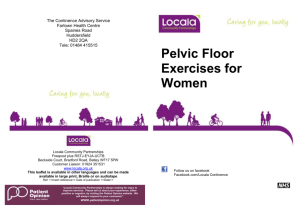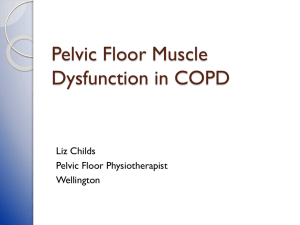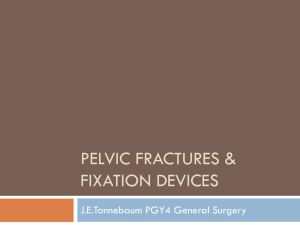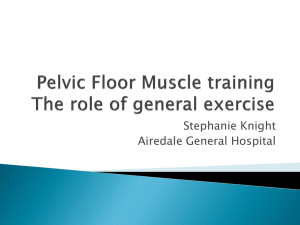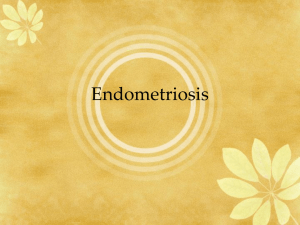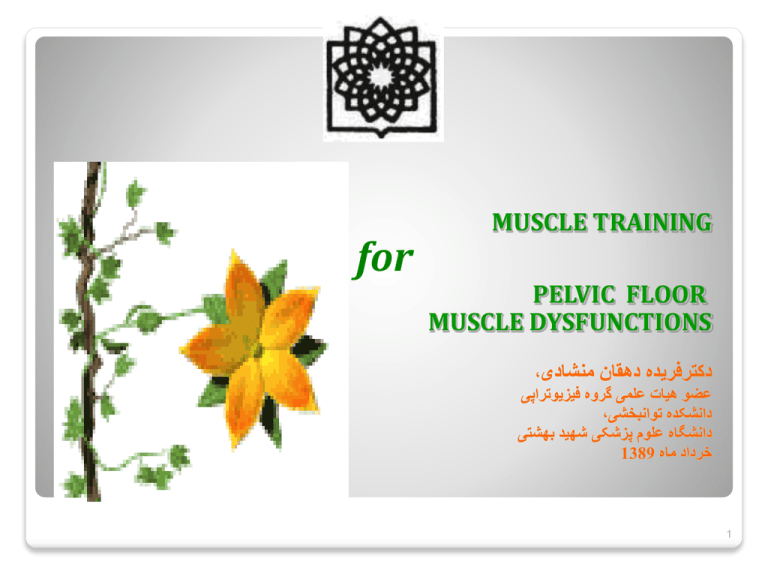
MUSCLE TRAINING
PELVIC FLOOR
MUSCLE DYSFUNCTIONS
دکترفریده دهقان منشادی،
عضو هیات علمی گروه فیزیوتراپی
دانشکده توانبخشی،
دانشگاه علوم پزشکی شهید بهشتی
خرداد ماه 1389
1
for
Muscles Inferior to the Pelvic Floor:The Urogenital Diaphragm
Muscles inferior to the pelvic
floor
Stretches between two sides of
the pubic arch in the anterior half
of the perineum
Contains
Deep transverse perineal muscle ◦
External urethral sphincter muscle ◦
The ischiocavernosus and
bulbospongiosus assist in
erection of the penis and clitoris;
lie superficial to the urogenital
diaphragm
2
3
The pelvic floor muscles have several functions:
Maintain alignment and support of the internal organs.
Control of urine flow.
Sexual enhancement.
Eliminate waste from the rectum.
If the pelvic floor is weak, it can contribute to:
Fall of the bladder or uterus through the pelvic floor
muscles due to lack of support.
Urinary/Anal incontinence
Limited sexual pleasure during intercourse.
Delayed recovery of tissue in the case of an episiotomy
4
5
Synergic Activation of Trunk & PFM Muscles:
Sapsford 2001 Devreese 2004,Smith,Madil 2007
2
از آنجا که عضالت کف لگن به عنوان بخشی از سیستم لوکال
ثبات دهنده ستون فقرات کمری و تنه مطرح می شوند .از این روی
اختالل سایر عضالت لوکال هم برفعالیت تونیک و هم بر زمان بندی
فعالیت فازیک انها در طی فعالیتهای عملکردی اثر می گذارد .برای
مثال کمر درد حاد با تاثیربر کنترل حرکتی عضله عرضی شکم سبب
کاهش حمایت تونیک عضالت کف لگن و بروز اختالالت عملکردی
چون بی اختیاری و بیرون زدگی می شود
7
Different Aspects of PFM
Function
Continence
Sjodahl
Postural
Control
Respiratory
function
PF
Unit
Pool-Goudwaard
2004:
Spinal
Stiffness
Sij Motion
&
Stability
8
9
10
Box 1. Symptoms of pelvic floor dysfunction
Lower urinary tract
Urinary incontinence
Urgency and frequency
Slow or intermittent stream and straining
Feeling of incomplete emptying
Bowel
Obstructed defecation
Functional constipation
Faecal incontinence
Rectal/anal prolapse
Vagina
Pelvic organ prolapse
Pain
Chronic pelvic pain
Pelvic pain syndrome
Sexual function
Dyspareunia (painful sexual intercourse)
Orgasmic dysfunction
11•
Lifestyle
Biofeedback
PFMT
PT Approaches
For PFD
Behavioral
Therapy
Neo-Control
Electrical
Stimulation
12
Management Theories
1-Theories Which are basis
for Surgical interventions:
Extrinsic(Delancey 1998, Umek
2002, Kyu-Jung Kim 2001,
Delancey 2005, Robert 2006? )
-Integral(P.Petros 1996-2009)
The Integral Theory states that
PFD symptoms are mainly caused
by connective tissue laxity in the
vagina or its supporting ligaments
2-Theories Which are basis for
conservative Interventions
Intrinsic (Kegel since 1948,ICS •
Approach, European PT, e.g:BØ)
Synergy Co-activation of PF &
•
Abdominal Muscles
(Aus. PT,e.g: Sapsford since 2001)
Hidden self-care or Knack
Mechanism (Ashton-
•
Miller,2001,2008)
Functional Training(Carriere •
2002)
13
14
Pelvic Floor Muscle Training
Strong evidences to suggest that for women
with stress, urge and mixed incontinence
PFMT is better than no treatment
Reasons why PFMT should be an Effective Measure
1-Strengthening PFM’S->better support for
the urethra under “stress”
2- Morphological changes occurring after
strength training
3-Trained muscles might be less prone to
injury or? Easier to return after damage
4-Previously trained muscle has a greater
strength reserve
15
Five Steps for PFM Training in PFD
1-Knack Maneuver (Ashton –Miller 1998,2008)
Teaching women to tighten their PFM
in preparation for a known leakage provoking event
(Hidden self-care Mechanism)
2- Pelvic floor strengthening:kegel Exe. Teaching
Women to set aside time to contract the PFM as a
repetitive exe. For strength
development &enhancement of reflex responses
3-Lumbo-Pelvic Stabilization Exs..
4-Functional Training/PFM Contraction during ADL
5-Correction of biomechanical/structural
deformities
16
Step One:
Pelvic Floor Contraction With the
moment of Expected Leakage to
Prompt Cough-Related Stress
Incontinence
KNACK MANEUVER
17
Theoretical Explanation
Active contraction of both Levator
Ani & Ext.Urethral Sphincter->
increase both stiffness in urethral
Supporters and urethral pressure
->
resist urine outflow
18
How to Teach Kegel Correctly!!
Verbal descriptions are only 40%
effective.
Palpate perennial tissues through
clothes, should feel tissues
move away from finger.
Watch patient kegel(give pt.
a mirror)
Place finger inside patient’s
vagina and pt squeeze
Sex Exercises when patient
is ready to resume sexual activity
19
Partii: Trans
Abdominal US
Bladder transverse
view at rest &
PFM Contraction
20
Benefits of PFM Training
Exercised muscles recover better
from trauma. (deliveries,
episiotomies, forceps/vacuum,
prolonged second stage of labor,
etc.)
Decreased swelling and pain in
perineum
Prevention &treatment of
Urinary Incontinence
Improved sex life
Strong evidences to suggest that
for women with stress, urge and
mixed incontinence PFMT is
better than no treatment
(Hay-Smith et al 2001)
A study by Wilson et al (1996)
showed a reduction in the
prevalence of UI postnatally in
women who had performed
pelvic floor exercises
antenatally.
The use of PFE’s is the main
non-surgical treatment for UI
and has been shown to be more
than 80% effective.
21
Once you have found the correct muscles, and know what
it feels like when you tense them, you should do the
following exercises.
Tense the muscles so you feel a lifting sensation. Hold this
lift for as long as you can up to 10 seconds. Don't hold
your breath whilst doing this. Relax. You should have a
definite feeling of letting go.
Wait 10-20 seconds then repeat the ?lift?. You should aim
to lift then relax 12 times.
Do 5-10 short fast lifts.
You should try to spend 5-10 minutes each day on this
exercise routine.
Samples of Some Kegel Exe.
22
(1)Lying Position
(2)Semi-Reclined
23
(3) Sitting Position
Kneeling on all
fours(4)
24
(5)Standing, leaning forwards from the hips with
hands flat on the table(Left) and
(6)Upright Standing(Right)
25
Some Points during Kegel Exs.
Make sure patient is breathing through
contractions of pelvic floor muscles.
(Can be difficult post-cesarean)
Teach patient about accessory muscles
(abdominals, gluteals)
Rest hand on patient’s abdominal to
make sure they are not contracting
those muscles
For patient with very weak
musculature, you can teach overflow
exercises using hip adductor
muscles(Controversial)
26
The pelvic floor muscles are programmed to work
with the innermost abdominal muscle, Transverse
Abdominis (TrA) as both are part of the core
stability mechanism.
Step 3 :
Lumbo –Pelvic
Stabilization Exs.
27
Lie on
your
back with
your
knees
bent.up nor
Keep your
spine
in neutral
position,
neither
arched
flattened against the floor.
Inhale deeply and relax your stomach.
Exhale slowly pulling your lower
abdomen inwards toward the floor.
Repeat this maContinuing regular
breathing and hold the tension for
10 seconds.
never up to 10 times.
Abdominal Hollowing
28
Abdominal hollowing
29
30
This exercise strengthens your back, hip, and abdomen
muscles.
Kneeling on hands and knees, place your hands directly
under your shoulders and your knees under your hips.
Inhale deeply.
While slowly exhaling, pull in your abdomen, and tighten
your buttocks and pelvic floor muscles. This should curve
your spine into a “C.” Relax, keeping your back straight
(don't allow it to curve toward the floor).
Do this exercise 8 times
or to your comfort level.
31
32
Slowly, while thinking about contracting your
stomach muscles (also your pelvic floor muscles), lift
one foot off of the floor. Hold for a count of 3 seconds
and then alternate the lift to your other leg
33
keep your knees straight, hands out to your sides,
and lift your hips high into the air. Make sure you
are contracting your Pelvic Floor muscles and
abdominal muscles. Then, draw the ball back
towards you, as far as you can
34
Pelvic Floor Exercises
36
Step 4
37
38
Functional Fitness Exercises…
39
Functional Fitness Exercises…
40
Step 5
41
42
43
44
Some Points from our recent Study
Assessment of Posture specially in Lumbopelvic region for
women with SUI
Asking about other PFD & Musculoskeletal pain in LP
region
Teaching PFM Contraction by different types of
Biofeedback
Adding TrA Training for SUI Patients
Doing PFM exercises in Crook lying pos. specially for SUI
women
Keeping Neutral Position in LP region while doing PFM
exe.,Also we can recommend active PPTilt as an
additional exe. For SUI patients
4•
Thanks
for your
Attention
46


